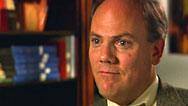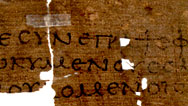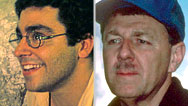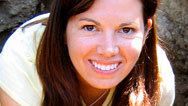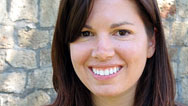Papyrus
PBS air date: November 21, 2006
NEIL DEGRASSE TYSON: When I was a kid, I used to play this
game, Password(TM). And the secret password is always
invisible, hidden until you slid the paper into this sleeve, and then the
secret word is revealed.
Well, what if the secret words aren't part of a kids' board game, but
instead are on a crumbling, ancient manuscript?
Correspondent Beth Nissen caught up with investigators who are uncovering
secret messages that have stayed hidden for 2,000 years.
BETH NISSEN (Correspondent): In these vaults, on these
shelves, in these boxes at Oxford University, ancient clues—2,000 years
old—to a glorious human past; wrapped in printed paper, fragments of
ancient paper, pieces of the D.N.A. of Western Civilization.
ROGER T. MACFARLANE (Brigham Young University): Here's one that
contains a large page of Homer's Odyssey, still with quite a bit of mud
and sand clinging to it.
BETH NISSEN: These are only a few of the faded fragments found
buried near the outskirts of what was, at around the turn from B.C. into A.D.,
a mid-sized capital city in Greek-ruled Egypt, the city of
Oxyrhynchus—actually, found buried in the Oxyrhynchus city dump, in
rubbish mounds.
ROGER MACFARLANE: There can be more Homer, new pieces of Sophocles,
Euripides, other authors who were being read in antiquity. You never really
know what's going to come out of the box.
BETH NISSEN: Or whether what comes out of the box can be read.
JOSHUA D. SOSIN (Duke University): Abrasion, dirt, clay, silt: an
awful lot can go wrong, when something is buried underground for 2,000
years.
BETH NISSEN: Yet somehow, buried above the water tables and
beneath the dry sands of Egypt, for all those centuries, almost half a million
of these papyri fragments survived, these pieces of ancient paper made from
papyrus.
JOSHUA SOSIN: Papyrus is a plant. It is a reed that grows almost
exclusively along the banks of the Nile. You shave the stalk into thin
strips, lay them parallel to each other, lay strips running perpendicular to
them; you pound it or press it, such that the cell walls break down. Cellulose
seeps out, creating a kind of gooey natural glue that binds the strips
together, which can then be pressed, polished and written on. The stuff is
really quite durable, in a way, more durable than the paper you're used to
taking notes on today.
BETH NISSEN: The tons of this reedy paper found at Oxyrhynchus
documented the daily life of an ancient city's markets and businesses and
courts.
JOSHUA SOSIN: We have marriage contracts, divorce contracts, tax
declarations, census registers, hate mail, dinner invitations. We have
letters-home-to-Mom. You name it, we have it on papyrus.
BETH NISSEN: Thousands more of the Oxyrhynchus fragments were
unreadable, soiled, grimy.
BENJAMIN HENRY (The University of Texas at Austin): Because this
was a rubbish dump, things get charred—if burning waste was put on top of
them —or stained.
BETH NISSEN: Or, like this fragment, which looks, at first,
like the work of, say, Jackson Pollack of Crete. The only readable word of
Greek is just visible at the very bottom. You can read "Christos."
BENJAMIN HENRY: Yeah, there's "Christos," kind of a row sigma with a bar
above it. So that's the abbreviation for "Christos," you know it's a Christian
text. But much of it is totally illegible.
BETH NISSEN: And papyrologists assume there are letters there.
Papyrus was too expensive to throw away unused and often had writing on both
sides. But texts like this were a tantalizing, frustrating mystery.
BENJAMIN HENRY: Really, you're never going to be able to publish a text
like this. You can look at that under the microscope as much as you like, but
it's just a complete mess.
BETH NISSEN: What papyrologists really needed was
this—an equivalent to Superman's x-ray vision—a way to see through
whatever was on the surface of papyri—ancient food stains, burn marks,
mummy paint—see through to the writing underneath.
As the ancient Greek scientist Archimedes is said to have said from his
bath: Eureka!
It's called multispectral imaging, a technology developed by NASA to "see
through" clouds of gas in space.
ROGER MACFARLANE: It was a significant step forward, when a scholar at
NASA's Jet Propulsion Laboratory decided to apply the technology to texts.
BETH NISSEN: Ancient texts, written on papyri.
The project today: see if multispectral imaging can help scholars at the
University of California at Berkeley read part of an account of the Trojan War,
by the poet Dictys of Crete, a part obscured by a large reddish stain.
ROGER MACFARLANE: Some people think it's a spill, a chemical spill
perhaps, or a spot of wine that was dropped on it. Even the best papyrologists
who've worked on this are usually not able to pick out any more than a few
scattered letters in here, and even at that, they feel like they're
guessing.
BETH NISSEN: The fragile fragment is put on a moving imaging
bed under a scientific-grade digital camera, which captures high-definition
images of the fragment, through a succession of color filters, one filter at a
time, a dozen different filters in all.
ROGER MACFARLANE: Each individual filter allows only a certain portion
of the light spectrum through.
BETH NISSEN: The light in the range of the spectrum visible to
the naked eye, reflects off whatever is on the surface of most of the papyri
pieces, the stains, dirt, mummy paint, whatever. The camera can't see much more
through these filters than the eye can, which isn't much.
But results tend to be better, using the filters that let in the range of
the light spectrum the human eye cannot see.
ROGER MACFARLANE: I've seen the best results in the infrared at 950
nanometers.
BETH NISSEN: Light in the infrared part of the spectrum,
invisible to the naked eye but not the camera, is more likely to pass through
what's on the papyrus surface to the ink underneath. Surface stains and dirt
fade away. The inked letters appear; black magic.
BENJAMIN HENRY: Ink, which is pretty much pure carbon—it's made
out of soot mixed with glue—will absorb all of the infrared, and so it
will come out black.
BETH NISSEN: Every time they see this 21st century technology
work on first or second century fragments, papyrologists are thrilled, or as
thrilled as papyrologists get.
ROGER MACFARLANE: None of us is really inclined to give high-fives and
celebrate too much, but we were really pleased.
BETH NISSEN: They've been pleased with multispectral imaging
at Oxford, too— home of the world's largest collection of ancient papyri:
all those fragments excavated from the Oxyrhynchus city dump.
They have as many as 500,000 fragments, but only about one percent have
been read and published by the few scholars working on them. Uncounted
thousands are illegible, in shreds, soiled.
BENJAMIN HENRY: There are fragments there that we'd pretty much
completely given up all hope of ever being able to read.
BETH NISSEN: Like that Jackson Pollack-y fragment that had the
word "Christos" on it.
BENJAMIN HENRY: We put it under the multispectral imaging camera, and,
all of a sudden, the background completely drops out, and wherever there was
ink, you can read the ink as clear as the day it was written.
BETH NISSEN: And what was written? A passage from the New
Testament, St. Paul's "Epistle to the Romans," Chapter 14, Verses 7-9.
BENJAMIN HENRY: And then "Eis touto gar Christos apethanen," "for this
reason did Christ die." And it is now our earliest copy for these verses. We
did have another third century papyrus of the "Epistle to the Romans," but it
actually is very fragmentary. But now, we've got a complete text of these
verses in a late second and early third, perhaps, century copy.
JOSHUA SOSIN: I don't know how long we have, until the things sitting in
shoeboxes in this or that university turn to dust, but we've got to get
rolling. There are a great many, I mean, many thousands of papyri that are
sitting in boxes in dark hallways, waiting to be read.
